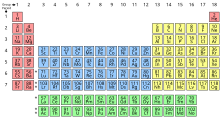Problems In High School Chemistry/Inchem/Elements
What are elements? Are they all the same? you've always heard of them, but what really are they?
Elements are the things you see when you look at the periodic table of elements, they make up everything we see in our daily lives like water, oxygen, etc. Elements are made up of atoms which are the fundamental unit of matter, of course not all atoms are the same, and consequently not all elements are the same, there are many different elements that are made up of many different atoms. An element will always have the same type of atoms in it, the number may vary, but the one thing that has to remain true is that each element has a specific designated atom, if 2 or more atoms that belong to different elements were to bond together that would create a compound.
Since all elements are different they all have different properties to them some of the biggest properties in elements are malleability (the ability to bend or change shape without breaking), conductivity (the ability to carry or transfer electricity), dissolving (in water),Luster (Shiny enough to be a mirror), and reactivity to air. Depending on the properties that each element has they can be grouped together, for example, Copper (Cu) and Silver (Ag) are both lustrous, conductive, and malleable which makes them very similar elements and so they can be grouped together, how do you know what elements are grouped together? usually you would have to test the elements and then compare their properties, but thanks to years of research a table was created that has already grouped the elements, this table was called the periodic table of elements.

Periodic table The periodic table is a table made to classify and describe all elements. It has 118 elements and some are naturally occurring and some can only be found in a lab. These elements are divided into 2 main groups, metals and non-metals, but if you look closer, there are smaller groups, such as earth metals, noble gases, etc. Just by using the periodic table you can see the elements details, such as atomic mass, atomic number and if they are metals or non-metals. An element's group is determined by the similarity in it's properties, to put it simply, the more similar 2 elements are the more likely they are to both be in the same group, some of the biggest characteristic of metals are being conductive, being lustrous, and being malleable. Non-metals could be described as the complete opposite of metals, their biggest characteristics are being non conductive, being dull (not lustrous), and being brittle (not malleable).
But how do you know what properties and element has if you don't want to use the periodic table?
You test it, there are always tests you can do to find the properties of any element, even though some elements are going to be harder to test you will always be able to test their properties, each designated property for elements has a test that you can use to see whether the element you have possesses that property or not. What are the tests?
Luster: Any object that has the property of luster will be very shiny to the point where you can see your own reflection.
Malleability / Ductility: Malleability and ductility are essentially the same thing, to test it, grab a piece of the element and try to bend it or smash it, if the element does not break or shatter that means the element is malleable.
Conductivity: Since conductivity is the ability to conduct electricity you will need a battery and a light bulb in order to test the conductivity, hook up 2 cables to the battery and then connect the cables to a light bulb, the light bulb should light up, after doing that run the cables through the element and then to the light bulb, if the element is conductive the light bulb should light up, if not then the element is not conductive.
Dissolving: To test if an element is dissolving put it in a beaker or cup full of water and try to stir it, if the element seems like it mixed with the water it is dissolving, if not and the element remains in a solid shape then it is not dissolving.
Reactivity to air: Different elements react to air differently, but a very simple test to see if they are reactive to air would be scratching the surface of the element, if it looks different in the inside it means that it is reactive to air because the inside hasn't reacted to the air so it looks different.